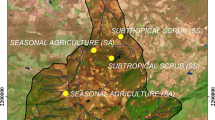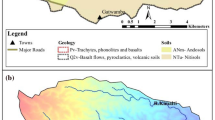Abstract
Ecological-hydrological analysis of erosion processes on the key watersheds of Southern Ural steppe was used to determine the surface runoff as a function of the physico-geographic and anthropogenic conditions, i.e., snow storage and soil moisture reserves before winter, whose contribution reaches 68–81%. The rate of humus losses in chernozems and dark chestnut soils was calculated for different periods in accordance with erosion stress and the extent of the economic development of the territory. Agroecological types of arable lands with different surface runoff characteristics, rates of natural soil formation, and erosionrelated soil losses are identified. Measures aimed to reduce humus losses in soils are proposed. Relationships between the rates of soil formation and erosion losses are proposed to be used as ecological-hydrological criterion (index) of soil stability.
Similar content being viewed by others

References
Alekseeva, N.K., Milanova, E.V., Kale, V.S., and Patna, D.N., Regional Studies of the Acceptability of Landscapes for Agriculture, Geogr. Prir. Res., 1995, no. 2, pp. 159–167.
Aliev, S.A., Azotfiksatsiya i fiziologicheskaya aktivnost’ organicheskogo veshchestva pochv (Nitrogen Fixation and Physiological Activity of Soil Organic Matter), Novosibirsk: Nauka, 1988.
Barabanov, A.T. and Lomakin, M.M., Prediction of Melt-Water Runoff, Vestn. S.-Kh. Nauk, 1989, no. 9, pp. 133–135.
Bel’gibaev, M. and Dolgilevich, M.I., On Maximum Admissible Level of Soil Erosion, Tr. VNIALMI, 1970, no. 1, pp. 239–258.
Burykin, A.M., Erosion Rate in Natural and Technogenic Landscapes, Pochvovedenie, 1986, no. 4, pp. 80–89.
Vershinina, L.K., Characteristics of the Distribution of Snow Cover and Spring Snow Melting on Kustanai Province Territory, Tr. Gl. Geofiz. Obs. im. A.I. Voeikova, 1963, no. 104, p. 11.
Vol’ftsun, I.B., On the Formation of Melt-Water Overland Flow in Kustanai Province, Tr. Gl. Geofiz. Obs. im. A.I. Voeikova, 1963, no. 104, p. 19.
Gennadiev, A.N., Pochvy i vremya: modeli razvitiya (Soils and Time: Models of Development), Moscow: Mosk. Gos. Univ., 1990.
Gerasimov, I.P., Geneticheskie, geographicheskie i istoricheskie problemy sovremennogo pocvovedeniya (Genetic, Geographic, and Historical Problems of Present-Day Soil Science), Moscow: Nauka, 1976.
Glushkov, V.G., Geographic-Hydrological Method, Izv. GGI, 1933, no. 57/58, pp. 5–9.
Graf, D., Characteristic of Geoecological Stability of Landscapes for the Development of Standard Loads: Case Study of Soil Water Erosion, in Nauchnye podkhody k opredeleniyu norm nagruzok na landshafty. Mater. KhIV nauch.-koord. soveshch. i simpoz (Scientific Approaches to the Determination of Standard Loads on Landscapes), Moscow, 1988, pp. 180–184.
Dokuchaev, V.V., Publichnye lektsii po pochvovedeniyu i sel’skomu khozyaistvu (Public Lecture on Soil Science and Agriculture), Moscow: Akad. Nauk SSSR, 1933.
Dokuchaev, V.V., Russkii chernozem: Otchet Vol’nomu ekonomicheskomu obshchestvu (Russian Chernozem: Report to Free Economic Society), Moscow: Sel’khozgiz, 1952.
Evdokimova, T.I., Bystritskaya, T.L., Vasil’evskaya, V.D., et al., Biogeochemical Cycles of Elements in Natural Zones of European Part of the USSR, in Biogeokhimicheskie tsikly v biosfere (Biogeochemical Cycles in the Biosphere), Moscow: Nauka, 1976, pp. 154–183.
Zaslavskii, M.N., On the Admissible Norms of Erosion and the Issues of Enhancing Soil Fertility, in Aktual’nye voprosy eroziovedeniya (Urgent Problems of Erosion Studies), Moscow: Mosk. Gos. Univ., 1984, pp. 118–137.
Ivanov, V.D., Substantiation of Dynamic Equilibrium Boundary between Soil Erosion and Soil-Formation Rate on Ploughed Slopes, Pochvovedenie, 1984, no. 1, pp. 85–91.
Ivanov, V.D., Ryazantsev, V.K., and Semenov, O.P., Overland Flow of Melt Waters in Central Chernozem Region and Its Transformation under the Effect of Natural and Anthropogenic Factors, Pochvovedenie, 1986, no. 4, p. 30.
Kiryushin, V.I., Kontseptsiya adaptivno-landshaftnogo zemledeliya (Concept of Adaptive-Landscape Farming), Pushchino, 1993.
Kliment’ev, A.I., Scientific Principles of Soil Protection against Erosion in the Steppe Zone of the Southern Urals, Extended Abstract of Doctoral (Agric.) Dissertation, Moscow: TSKhA, 1994.
Krupenikov, I.A., Soil Cover and Erosion, in Ekologicheskie aspekty zashchity pochv ot erozii (Ecological Aspects of Soil Protection Against Erosion), Chisinau: Kartya Moldovenyasko, 1990, pp. 4–16.
Kudeyarov, V.N. and Kuznetsova, T.V., Assessment of the Extent of Non-Symbiotic Nitrogen Fixation in Soil by Balance Method, Pochvovedenie, 1990, no. 11, pp. 79–89.
Letkov, L.A., Soils of the Northern Forest-Steppe in the Foothill Plain of Transuralia and Low Mountains of the East Slope of the Southern Urals, Tr. Pochvennogo Inst. Akad. Nauk SSSR, 1934, vol. 13, pp. 28–39.
Lykov, A.M., On the Method for Calculating Humic Balance of Soils in Intensive Farming, Izv. Timiryazevsk. S.-Kh. Akad., 1979, no. 6, pp. 14–20.
Mazyro, M.M., Pochvy Yuzhnoi Chasti Orenburgskogo Uezda Orenburgskoi Gubernii (Soils of the Southern Part of Orenburg District, Orenburg Province), Orenburg: Orenburgskoe Kn. Izd., 1926.
Makkaveev, N.I., Ruslo reki i eroziya v ee basseine (River Channel and Erosion in Its Basin), Moscow, 1955.
Mirtskhulava, Ts.E., Inzhenernye metody rascheta i prognoza vodnoi erozii (Techniques for Calculating and Forecasting Water Erosion), Moscow: Kolos, 1970.
Mishustin, E.N. and Cherenkov, N.I., The Role of Biological Nitrogen in Nitrogen Balance of Agriculture in the USSR and in Enhancing of Soil Fertility, Izv. Akad. Nauk SSSR, Ser. 16, Biol., 1987, no. 5, pp. 649–660.
Neustruev, S.S., Soil Studies in Orenburg Province, Izv. Dokuchaevskogo Pochv. Komiteta, 1916, no. 3/4, pp. 129–149.
Neustruev, S.S., Buzuluk District: Soil and Geography Description, in Materialy dlya otsenki zemel’ Samarskoi gubernii. Estestvennoistoricheskaya chast’ (Materials for Land Assessment in Samara Province. Naturalistic Part), Samara: Petrograd, 1916, vol. 6.
Neustruev, S.S., Soils and Erosion Cycles, in Materialy po geografii i kartografii pochv SSSR (Materials on Geography and Cartography of Soils of the USSR), Leningrad: Akad. Nauk SSSR, 1949, pp. 7–17.
Orlovskii, N.V., Materialy K Poznaniyu Pochv Buzulukskogo Opytnogo Polya (Materials for Studying Soils of Buzuluk Experimental Field), Buzuluk, 1926.
Patsukevich, Z.V., Admissible Soil Washout and Methods for Its Assessment, Vestn. Mosk. Univ., Ser. 5, Geogr., 1996, no. 2, pp. 25–30.
Polevoi, A.N., Prikladnoe modelirovanie i prognozirovanie produktivnosti posevov (Applied Modeling and Forecasting Crop Productivity), Leningrad: Gidrometeoizdat, 1988.
Poluektov, E.V., On Maximum Admissible Extent of Soil Erosion, Pochvovedenie, 1981, no. 2, pp. 148–156.
Prasolov, L.I. and Datsenko, P.I., Pedological-Geological Description of Buguruslan District, in Materialy dlya otsenki zemel’ Samarskoi gubernii. Estestvennoistoricheskaya chast’ (Materials for Land Assessment in Samara Province. Naturalistic Part), St. Petersburg, 1909, vol. 4.
Rozhanets, M.I., Pochvy Yugo-Vostochnoi Chasti Orskogo Uezda Orenburgskoi Gubernii (Soils of Southeastern Orsk District, Orenburh Province), Orenburg, 1926.
Rozhanets, M.I. and Rozhanets-Kucherovskaya, S.S., Pochvy I Rastitel’Nost’ Orenburgskoi Gubernii (Soils and Vegetation of Orenburg Province), Orenburg, 1928, vol. 54.
Stok nanosov, ego izuchenie i geograficheskoe raspredelenie (Sediment runoff, Its Studying and Geographic Distribution), Karaushev, A.V., Ed., Leningrad: Gidrometeoizdat, 1977, pp. 119–121.
Titlyanova, A.A., Kiryushin, V.I., and Okhin’ko, I.P., Agrotsenozy stepnoi zony (Agrocenoses of Steppe Zone), Novosibirsk: Nauka, 1984.
Shatilov, I.S., Zamaraev, A.S., and Chapovskaya, G.V., Nitrogen Balance in Crop Rotation on Sod-Podzolic Soil, Izv. Timiryazevsk. S-Kh. Akad., 1977, no. 1, pp. 34–45.
Shikula, N.K., Rozhkov, A.G., and Tregubov, P.S., K voprosu kartirovaniya territorii po intensivnosti erozionnykh protsessov i deflyatsionnykh zemel’ (On Mapping of Territories by the Rate of Erosion Processes and Deflation Lands), Moscow: Mosk. Gos. Univ., 1973.
Author information
Authors and Affiliations
Additional information
Original Russian Text © A.I. Kliment’ev, A.A. Chibilev, Yu.M. Nesterenko, I.V. Lozhkin, D.G. Polyakov, 2010, published in Vodnye Resursy, 2010, Vol. 37, No. 1, pp. 105–116.
Rights and permissions
About this article
Cite this article
Kliment’ev, A.I., Chibilev, A.A., Nesterenko, Y.M. et al. Water erosion in the Southern Ural steppes. Water Resour 37, 102–112 (2010). https://doi.org/10.1134/S0097807810010100
Received:
Published:
Issue Date:
DOI: https://doi.org/10.1134/S0097807810010100



